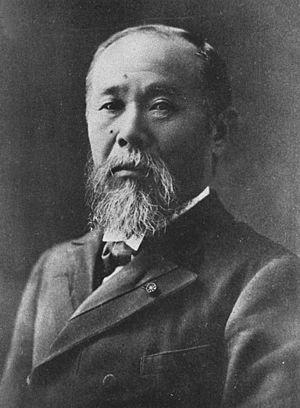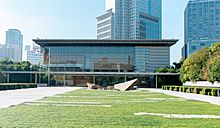Prime Minister of Japan facts for kids
Quick facts for kids Prime Minister of Japan |
|
|---|---|

Standard of the Prime Minister of Japan
|
|

Crest of the Prime Minister of Japan
|
|
| Executive branch of the Japanese government Office of the Prime Minister |
|
| Style | Naikaku sōridaijin (formal) Her Excellency (formal and diplomatic) Shushō (informal and during party debates) Sōri (informal) |
| Member of | Cabinet National Security Council National Diet |
| Residence | Naikaku Sōri Daijin Kantei |
| Seat | Tokyo |
| Nominator | National Diet |
| Appointer | HM The Emperor |
| Term length | No fixed term
Resigns upon loss of confidence or House of Representatives opening; reappointable
|
| Constituting instrument | Constitution of Japan |
| Precursor | Daijō-daijin of Japan |
| Formation | 22 December 1885 |
| First holder | Itō Hirobumi |
| Deputy | Deputy Prime Minister |
| Salary | ¥40,490,000/ USD$ 257,597 annually |
The Prime Minister of Japan (called Naikaku Sōri Daijin in Japanese) is the leader of Japan's government. This important person guides the country and makes big decisions. The Prime Minister also leads the Cabinet of Japan, which is a group of top government officials. They can choose or remove these officials.
The Prime Minister is also the main leader of Japan's military, known as the Japan Self-Defense Forces. As of October 21, 2025, Sanae Takaichi is the Prime Minister. She is the first woman to hold this position in Japan's history.
Japan's parliament, called the National Diet, chooses the Prime Minister. This choice usually comes from the members of the House of Representatives. After the Diet chooses, the Emperor formally appoints them. The Prime Minister must keep the support of the House of Representatives to stay in office. They live and work in a special building called the Naikaku Sōri Daijin Kantei in Tokyo. This building is very close to the National Diet.
Many people have served as Prime Minister of Japan. The first was Itō Hirobumi, who started on December 22, 1885. The person who served the longest was Shinzo Abe. He was Prime Minister for over eight years in total. The shortest-serving Prime Minister was Prince Naruhiko Higashikuni, who served for only 54 days.
Contents
What is the Prime Minister of Japan?
The Prime Minister is the top leader of the Japanese government. They are in charge of the country's daily operations. The official Japanese title is Naikaku Sōri-Daijin. This means "Minister President of the Cabinet."
Different Ways to Say Prime Minister
In Japan, people use different names for the Prime Minister. The full title is Naikaku Sōri-Daijin. But it is often shortened to Sōri-Daijin. Sometimes, people just say Sōri or Shushō. These shorter names are used in everyday talk.
A Look at History: Japan's Leaders
Japan has a long history of leaders. Before 1885, Japan did not have a written constitution like today. The country was often led by powerful families or military leaders called shōgun. The Emperor was always the highest authority, but real power changed hands often.
First Prime Minister: Itō Hirobumi

The role of Prime Minister began in 1885. This was four years before Japan's first modern constitution. Itō Hirobumi was the very first person to hold this new position. The job became what it is today with the Constitution of Japan in 1947.
So far, 66 people have been Prime Minister. Shinzo Abe served the longest, for more than eight years. He held the office in two separate periods. Prince Naruhiko Higashikuni served the shortest time, just 54 days in 1945.
How is the Prime Minister Chosen?
The Prime Minister is chosen by the National Diet, Japan's parliament. Both houses of the Diet vote for a candidate. If they pick different people, they work together to agree. If they still can't agree, the choice of the House of Representatives becomes the final decision.
After the Diet chooses, the Emperor officially appoints the Prime Minister. This happens at the Tokyo Imperial Palace. The Prime Minister usually leads the biggest political party in the House of Representatives. Sometimes, they lead a group of parties working together.
Who Can Be Prime Minister?
To become Prime Minister, a person must meet a few requirements:
- They must be a member of the National Diet. This means they must be at least 25 years old. They also must be a Japanese citizen.
- They must be a civilian. This means they cannot be a serving member of the military. However, former military members can become Prime Minister.
What Does the Prime Minister Do?
The Prime Minister has many important jobs. They lead the entire government and make sure laws are followed. They also represent Japan to other countries.
Leading the Government
The Prime Minister oversees all parts of the government. They propose new laws to the Diet. They also sign laws and government orders. The Prime Minister chooses all the ministers in the Cabinet. They can also remove these ministers at any time.
Important Responsibilities
The Prime Minister leads Cabinet meetings. They are the Commander-in-chief of the Japan Self-Defense Forces. This means they are the top military leader. The Prime Minister must also report to the Diet about Japan's affairs. They answer questions from the Diet when asked. They can also suggest that the Emperor dissolve the House of Representatives.
The Prime Minister is the main decision-maker in Japan. They have a lot of power to lead the country.
Symbols of the Office
The Prime Minister has special symbols that represent their office. These include a flag and a crest.
Where the Prime Minister Works and Lives
The Prime Minister's main office is called the Naikaku Sōri Daijin Kantei. It is often just called the Kantei. This building is located near the Diet building in Tokyo.
A new Kantei building opened in 2002. The old Kantei building became the official residence, called the Kōtei. The Kōtei is connected to the Kantei by a walkway. This makes it easy for the Prime Minister to go between work and home.
How the Prime Minister Travels
The Prime Minister uses special vehicles for travel. For car travel, they use a Toyota Century. Before 2019, a Lexus LS 600h L was used, and it is now a backup car.
For air travel, the Japanese government has two Boeing 777 aircraft. These planes are also used by the Emperor and other important officials. They are known as Japanese Air Force One and Japanese Air Force Two. These planes always fly together, with one as the main transport and the other as a backup.
Images for kids
-
Former Prime Minister Shigeru Ishiba
-
Former Prime Minister Fumio Kishida
-
Former Prime Minister Yoshihide Suga
-
Former Prime Minister Yoshihiko Noda
-
Former Prime Minister Naoto Kan
-
Former Prime Minister Yukio Hatoyama
-
Former Prime Minister Tarō Asō
-
Former Prime Minister Yasuo Fukuda
-
Former Prime Minister Junichiro Koizumi
-
Former Prime Minister Yoshirō Mori
-
Former Prime Minister Morihiro Hosokawa
See Also
 In Spanish: Primer ministro de Japón para niños
In Spanish: Primer ministro de Japón para niños
- List of prime ministers of Japan
- List of spouses of prime ministers of Japan
- Air transports of heads of state and government
- Official state car
- Japanese Air Force One

















